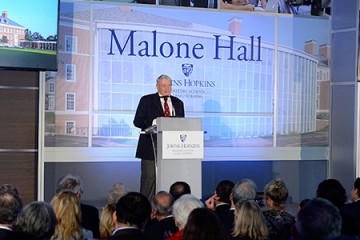Russell Taylor recalls the many hours he spent as a Johns Hopkins undergraduate writing computer programs in the Eisenhower Library for his adviser, Mandell Bellmore. The programs implemented an algorithm designed by another Bellmore advisee, John Malone. Taylor, Engr '70, couldn't have predicted that Malone, Engr '64 (MS), '69 (PhD), would one day become his benefactor.

Image caption: Russell Taylor, the John C. Malone Professor, tests a robot designed to help surgeons keep a steady hand
Image credit: Will Kirk / Johns Hopkins University
But in 2011, Taylor received the first in a series of professorships endowed by Malone, a pioneer in communications and media and current chairman of Liberty Media Corporation and Liberty Global Inc. The John C. Malone Professorships support faculty whose work crosses the borders of multiple disciplines, particularly engineering and medicine. To date, 10 faculty members have been named Malone Professors. All are part of the new John C. Malone Center for Engineering in Healthcare housed in Malone Hall, whose construction was supported by a previous gift from Malone in 2011.
"The commitment John Malone has made to our faculty through Malone Hall and these professorships ensures that, in partnership with our colleagues in the School of Medicine, we will deliver on our promise to help transform health care and make an impact on patients and systems around the world," says Ed Schlesinger, dean of the Whiting School.
Taylor has been making that kind of impact for decades. He joined the Johns Hopkins faculty in 1995 after working at IBM's Thomas J. Watson Research Center for 19 years. There, he led a team that developed the prototype for Robodoc, considered the first surgical assistant robot for major procedures. Taylor has licensed his patents to some of the world's largest medical robotics companies, and in 2015, he received the Honda Prize for his contributions in medical robotics.
"Engineering culture is very much about solving problems in the world," says Taylor, who directs both the Engineering Research Center for Computer-Integrated Surgical Systems and Technology and the Laboratory for Computational Sensing and Robotics at Johns Hopkins. "The constant in my research has been a partnership between physicians and robotics, and the desire to change processes. A lot of my work is focused on getting each individual patient the best intervention."
The Malone Professorship has allowed Taylor to build on his research in medical robotics by providing seed funding for projects like the new Galen Surgical System. Galen is a robot that helps surgeons keep a steady hand, increasing precision during head and neck microsurgery. A clinical version of the system is being produced by Galen Robotics Inc., a Johns Hopkins startup. Taylor has collaborated with surgeons, operations research managers, and other medical professionals on the project, and it has given him a chance to involve undergraduates in his work—just as Bellmore and Malone did for him decades ago. Mariah Schrum, a senior biomedical engineering student, says Taylor assigned her to design some of the robot's tools as well as the simulated body parts used for testing the machine. Schrum knows that such hands-on industry experience is rare for undergraduates.
The Malone funds Taylor received also provided seed funding for many other projects involving undergraduates. One of these is a collaboration with Sanaria, a biotechnology company based in Rockville, Maryland, that is developing a malaria vaccine using salivary glands extracted from Anopheles mosquitoes. Working with Schrum and then-undergraduate Amanda Canezin, Engr '17, Taylor developed tools that double the number of mosquitoes that technicians can process per hour and reduce the learning curve for technicians from 29 weeks to one and a half days. With funding from a National Institutes of Health grant, the team is now developing a fully automated robotic system for this process.
"Dr. Malone's gifts have helped us create partnerships [like Sanaria's] and have allowed us to expand research in very important ways for society," Taylor says. "The professorships and the Malone Center for Engineering in Healthcare facilitate a partnership between health care professionals, technology, and information to improve patient care. The increased resources also help recruit new faculty with strong interests in health care and translational applications and provide a specific meeting point for this kind of work."
That kind of exposure and collaboration is essential, especially for young faculty members, he says. Today, Taylor is widely considered the "father of medical robotics." But he knows that his foundational collaboration with Bellmore and Malone in the late '60s was the critical launching point for his current success. "The first time my name appeared in an academic publication was in one of John Malone's papers," Taylor says. "I guess it's a nice coincidence that I became the John C. Malone Professor."
Posted in Science+Technology










